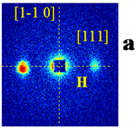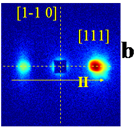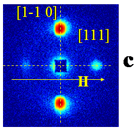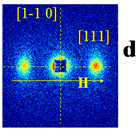Systems with Dzjaloshinskii-Moriya interaction under applied field: Fe1-xCoxSi and MnSi
V. A. Dyadkin, S.V. Grigoriev, S.V.Maleyev, A.I.Okorokov, Yu.O.Chetverikov (PNPI, Gatchina, St.Petersburg, Russia)
D. Menzel (Technische Universitat Braunschweig, Braunschweig, Germany)
P.Boni, D. Lamago, R.Georgii (TU Munchen, Garching, Germany)
H.Eckerlebe (GKSS Forschungszentrum, Geesthacht, Germany)
Fe1-xCoxSi and MnSi structure
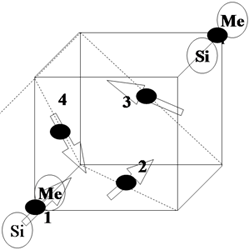
1) Space group P213, a = 0.4558 nm.
2) 4 Me-atoms and 4 Si atoms
(u,u,u), (1/2+u,1/2-u,u),
(1/2-u,-u,1/2+u) (-u,1/2+u,1/2+u)
with uMe = 0.138 and uSi = 0.845
3) ![]() with
with ![]()
for Fe1-xCoxSi where x = 0.05 –0.80.
![]() with
with ![]() .
.
4) period of the spiral 30 - 300 nm for Fe1-xCoxSi
period of the spiral 18 nm for MnSi.
5) ![]()
![]()
[1] Y. Ishikawa, K Tajima, D. Bloch and M.Roth, Soild State Commmun. 19 (1976) 525.
[2] Y. Ishikawa, G. Shirane, J.A. Tarvin, M. Kohgi, Phys.Rev.B 16 (1977) 4956.
[3] J. Beille, J. Voiron, M. Roth, Solid State Commmun. 47 (1983) 399.
Magnetic order and resistance in Fe1-xCoxSi and MnSi

NB!!! Magnetism and metallic properties are correlated at small x

The resistivity and magnetoresistance for crystalline Fe1-xCoxSi and polycrystalline MnSi versus temperature.
N. Manyala, Y. Sidis, J. F. DiTusa, G. Aeppli, D.P. Young, Z. Fisk, Nature 404 (2000) 581
Phase diagram
MnSi
|
Fe0.8Co0.2Si |
|
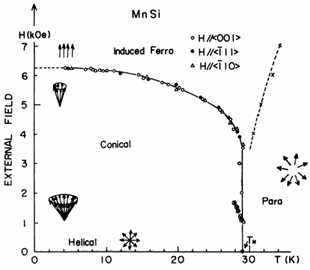 |
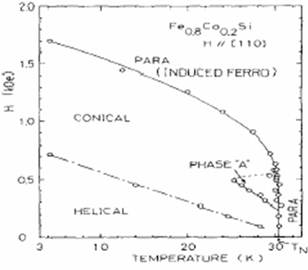 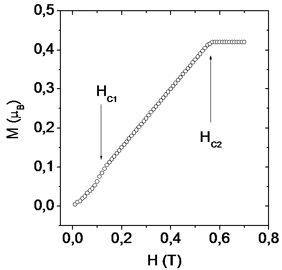 |
|
[1] Y. Ishikawa, G. Shirane, J.A. Tarvin, M. Kohgi, Phys.Rev.B 16 (1977) 4956. |
[2] K. Ishimoto, H. Yamaguchi, Y. Yamaguchi, J. Suzuki, M. Arai, M. Furusaka, Y. Endoh, J.Magn.Magn.Mat. 90&91 (1990) 163. |
Driving forces of cubic system with DM.
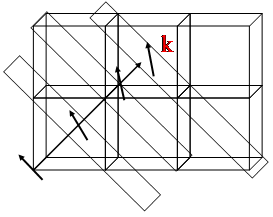
Free energy density
1) isotropic ferromagnetic exchange
W(q) = (A/2) (q2 + k02) Sq2 +
2) antisymmetric spin exchange Dzyaloshinskii-Moria (DM) due to lack of a symmetry center:
+ D (q [Sq ´ S -q])+
handedness (left) is determined by sign and value of D.
3) weak anisotropic exchange (AE) interaction fixes direction of spiral along <1,1,1> :
+ (F/2)(qx2 |Sqx| 2 + qy2 |Sqy| 2 + qz2 |Sqz| 2 )
[1] I.E. Dzyaloshinskii, Sov. Phys. JETP 19 (1964) 960.
[2] P.Bak, M.H.Jensen, J.Phys. C13 (1980) L881.
Driving forces of cubic system with DM
k-dependent part of the classical energy [P.Bak, M.H.Jensen, J.Phys. C13 (1980) L881.]
 |
Hierarchy of interactions: A >> D a >> F
For components of k: For k: |
Driving forces of cubic system with DM
Bak-Jensen model: ![]()
Driving forces in magnetic system of MnSi
Sci2 (ai2 + bi2) is maximal and equal to 2/3 at (k || c || [111]) and
is minimal and equal to 0 at (k || c || [100])
If F < 0, then Ecl is minimized at (k || c || [111]);
If F > 0, then Ecl is minimized at (k || c || [100]).
Interaction of the helix with the field
1) A k2 = g mB HC2 critical field of the induced ferromagnetism
2) k = S D/ A the helix wavevector
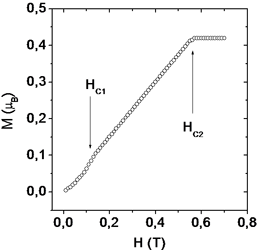 |
The field dependent part of the ground state energy [S.V. Maleyev, PRB 73 (2006) 174402 ] | |
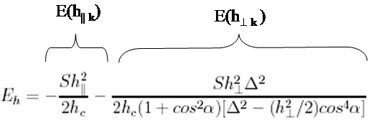 |
||
| E(h||) = h||k S sin a - classical Zeeman energy E(h^ k ) – quantum contribution describing the interaction of the helix structure with the field h^ k . |
Experimental geometry
 |
Bragg conditions:
|
Experimental setup
The installation SANS-2 at FRG-1 in Geesthacht (Germany).
P0=0.95, l=0.58 nm, (lD/l=0.1)
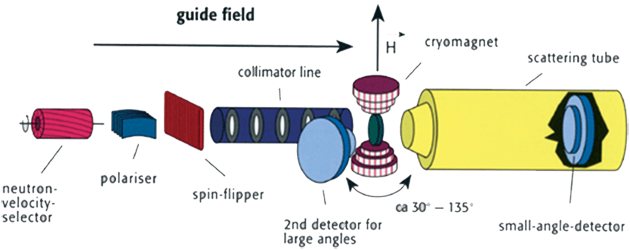
Field induced k-flop in MnSi near TC
S.V. Grigoriev, S.V. Maleyev, A.I. Okorokov, Yu.O. Chetverikov, H. Eckerlebe, Phys.Rev.B 73 (2006) 224440. |
T ~ TC
|
|
||||||||||||
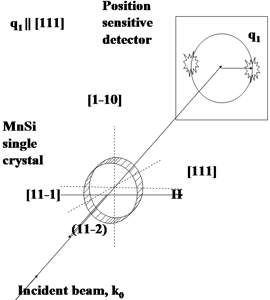 |
 |
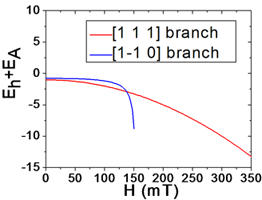 |
|
Conclusion: the existence of spin wave gap |
(Eh + EA)(H) for H || [111]: |
Magnetic field evolution
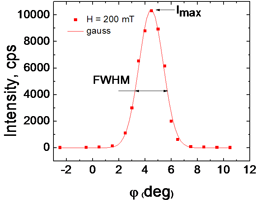 |
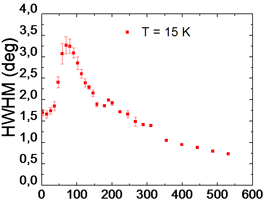 |
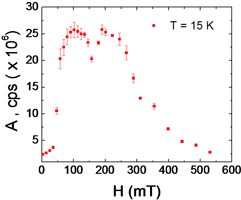 |
Rocking scan |
Magnetic mosaic |
Total intensity |
(H-T) Phase diagram
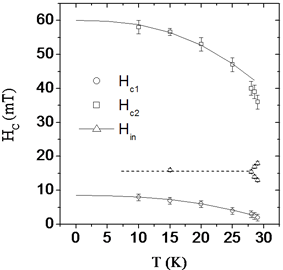
![]()
![]()
![]()
Fe1-xCoxSi : parameters of the system
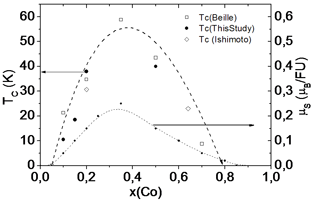
What are parameters of the system?
![]()
![]()
![]()
Maps of the SANS intensities for four different samples Fe1-xCoxSi and x = 0.10 , 0.15, 0.20, and 0.50
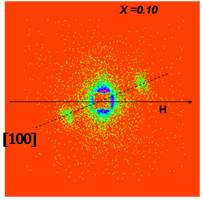

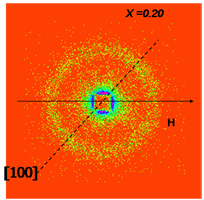
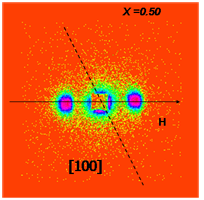
T = 9 K, H = 1 mT
Field evolution for Fe0.8Co0.2Si T = 10 K
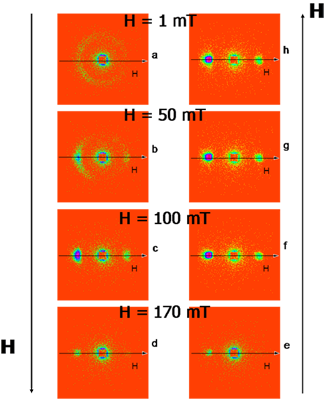
The magnetization curves taken at different temperatures T = 5, 10, 20, 30 K.
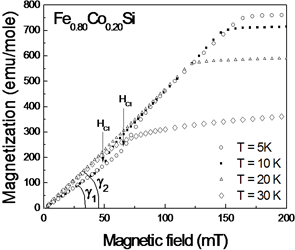
Data analysis: field evolution
The neutron intensity along the ring at q = qC, i.e. as a function of the angle between H and q for Fe0.8Co0.2Si at T = 10 K.

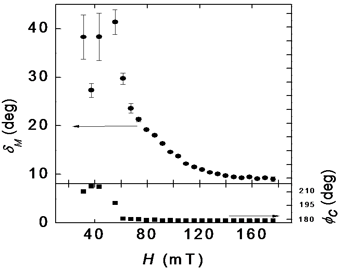
The integral neutron intensity as a function of the field at T = 10 K.
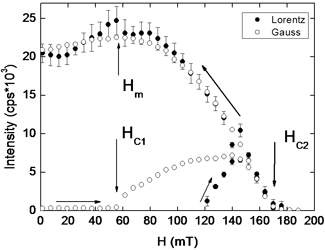
The center of Gaussian jC and the magnetic mosaic dM of the magnetic Bragg reflection (k || H) as a function of the magnetic field.
k-flop in Fe0.8Co0.2Si near TC |
H – T phase diagram |
|||
 |
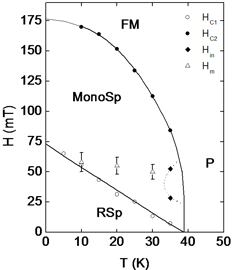 |
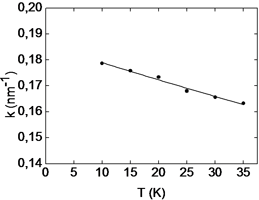 |
Parameters of the magnetic systemFe1-xCoxSi vs x
 |
 |
 |
||
 |
 |
 |
Conclusion
-
1. The spin wave stiffness as
2. The DM interaction ![]() was also estimated. The x-dependence repeats practically the magnetic T - x phase diagram showing that either D (DM interaction) or S is responsible for the order parameter of these compounds.
was also estimated. The x-dependence repeats practically the magnetic T - x phase diagram showing that either D (DM interaction) or S is responsible for the order parameter of these compounds.
3. The spin wave gap ![]() was obtained from the minimum in the field dependence of the peak intensity near T-C. It is shown that the value of the gap is
was obtained from the minimum in the field dependence of the peak intensity near T-C. It is shown that the value of the gap is ![]() .
.
